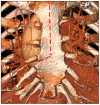Aortic Valve Replacement: Understanding Predictors for the Optimal Ministernotomy Approach
- PMID: 37959183
- PMCID: PMC10647482
- DOI: 10.3390/jcm12216717
Aortic Valve Replacement: Understanding Predictors for the Optimal Ministernotomy Approach
Abstract
Introduction: The most common minimally invasive approach for aortic valve replacement (AVR) is the partial upper mini-sternotomy. The aim of this study is to understand which preoperative computed tomography (CT) features are predictive of longer operations in terms of cardio-pulmonary bypass timesand cross-clamp times.
Methods: From 2011 to 2022, we retrospectively selected 246 patients which underwent isolated AVR and had a preoperative ECG-gated CT scan. On these patients, we analysed the baseline anthropometric characteristics and the following CT scan parameters: aortic annular dimensions, valve calcium score, ascending aorta length, ascending aorta inclination and aorta-sternum distance.
Results: We identified augmented body surface area (>1.9 m2), augmented annular diameter (>23 mm), high calcium score (>2500 Agatson score) and increased aorta-sternum distance (>30 mm) as independent predictors of elongated operation times (more than two-fold).
Conclusions: Identifying the preoperative predictive factors of longer operations can help surgeons select cases suitable for minimally invasive approaches, especially in a teaching context.
Keywords: aortic valve; aortic valve replacement; computed tomography; minimally invasive cardiac surgery.
Conflict of interest statement
The authors declare no conflict of interest.
Figures





References
-
- Leon M.B., Smith C.R., Mack M., Miller D.C., Moses J.W., Svensson L.G., Tuzcu E.M., Webb J.G., Fontana G.P., Makkar R.R., et al. Transcatheter Aortic-Valve implantation for aortic stenosis in patients who cannot undergo surgery. N. Engl. J. Med. 2010;363:1597–1607. doi: 10.1056/NEJMoa1008232. - DOI - PubMed
-
- Deeb G.M., Reardon M.J., Chetcuti S., Patel H.J., Grossman P.M., Yakubov S.J., Kleiman N.S., Coselli J.S., Gleason T.G., Lee J.S., et al. CoreValve USCI. 3-Year outcomes in high-risk patients who underwent surgical or transcatheter aortic valve replacement. J. Am. Coll. Cardiol. 2016;67:2565–2574. doi: 10.1016/j.jacc.2016.03.506. - DOI - PubMed
-
- Smith C.R., Leon M.B., Mack M.J., Miller D.C., Moses J.W., Svensson L.G., Tuzcu E.M., Webb J.G., Fontana G.P., Makkar R.R., et al. PARTNER Trial Investigators Transcatheter versus surgical aortic-valve replacement in high-risk patients. N. Engl. J. Med. 2011;364:2187–2198. doi: 10.1056/NEJMoa1103510. - DOI - PubMed
-
- Vahanian A., Beyersdorf F., Praz F., Milojevic M., Baldus S., Bauersachs J., Capodanno D., Conradi L., De Bonis M., De Paulis R., et al. 2021 ESC/EACTS Guidelines for the management of valvular heart disease: Developed by the Task Force for the management of valvular heart disease of the European Society of Cardiology (ESC) and the European Association for Cardio-Thoracic Surgery (EACTS) Rev. Esp. Cardiol. 2022;75:524. doi: 10.1016/j.rec.2022.05.006. - DOI - PubMed
LinkOut - more resources
Full Text Sources

